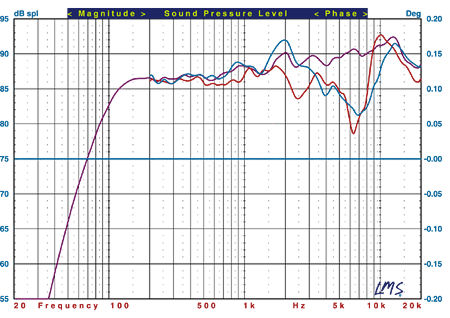Alón by Acarian Napoleon Surround Speaker System Measurements
The Alón Napoleon satellite's sensitivity measured approximately 87dB/W/m. Its ported cabinet is tuned to approximately 87Hz. Its minimum impedance is 6.25ohm at 338Hz, and its specified nominal impedance of 8ohm appears to be both reasonable and conservative. This speaker should be very easy to drive
The pseudo-anechoic response of the Napoleon at tweeter height, averaged over a 30° forward horizontal angle (+/-15°) and combined with the nearfield responses of the woofer and port, is shown in Fig.1 (violet). The useful bass extends down to approximately 72Hz (–10dB relative to the output at 150Hz). The front-axis averaged response has a gradually rising trend from the lower midrange to the high treble. This suggests that the speaker will be bright, but that rising response, and the response in general, are very smooth. The off-axis response curves, in fact, suggest that the speakers will sound best either firing straight ahead or toed-in at a sharp angle so that the tweeter axes cross well in front of the listener. The latter arrangement would work better for several listeners, the former for a single listener in the classic "sweet spot."

Figure 1
The relative lack of bass response suggests that the speakers will sound thin by themselves. For a well-balanced response, the Alón Napoleon speaker demands a good subwoofer, which is why it is sold only with the Thunderbolt subwoofer.
Fig.2 again shows the Napoleon's averaged horizontal front response (violet), plus the vertical responses taken at +15° (red) and –15° (blue) relative to the tweeter height. The off-axis curves have a deep suckout at 6–7kHz, which suggests that the Napoleon should be auditioned with the listener's ear height as close as possible to that of the tweeter axis.

Figure 2
While the curves aren't shown here, when the Napoleon is positioned horizontally—as might be done for center-channel duties—the same sort of suckout problems shown in Fig.2 turn up in the horizontal plane, but now centered at 2–4kHz (the frequency of the maximum dip changes with the angle), where they will reduce speech intelligibility for off-axis listeners. At 30° off-axis, the dip deepens to over 10dB at 4kHz. But there's an easy way around this problem: set up all three front speakers vertically. The cabinet is very small, so such an arrangement should be neither impractical nor unsightly.
These are respectable measurements for a moderately priced speaker, though they'd be even better if the upward tilt in the front-axis averaged response was reduced a bit. But the speaker's generally smooth response is a plus, making the Napoleon a good candidate for operation with THX re-equalization or a good treble control. But if you insist on turning it on its side for center-channel duties, try to stay out of any seats far off-axis.—Thomas J. Norton
- Log in or register to post comments





























































